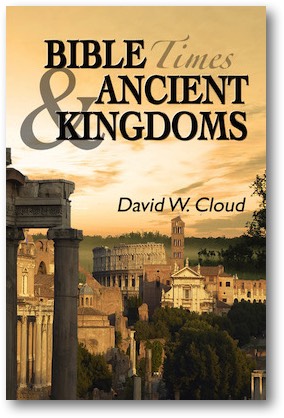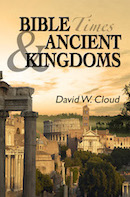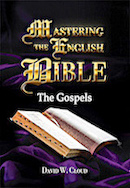866-295-4143, fbns@wayoflife.org

_______________
☛ A PowerPoint presentation of this material is included
in the Bible Times and Ancient Kingdoms package. See “PowerPoints and Teaching Tips” at the beginning of the course for more information.
“And when the queen of Sheba heard of the fame of Solomon concerning the name of the LORD, she came to prove him with hard questions. And she came to Jerusalem with a very great train, with camels that bare spices, and very much gold, and precious stones: and when she was come to Solomon, she communed with him of all that was in her heart. And Solomon told her all her questions: there was not any thing hid from the king, which he told her not. And when the queen of Sheba had seen all Solomon’s wisdom, and the house that he had built, And the meat of his table, and the sitting of his servants, and the attendance of his ministers, and their apparel, and his cupbearers, and his ascent by which he went up unto the house of the LORD; there was no more spirit in her. And she said to the king, It was a true report that I heard in mine own land of thy acts and of thy wisdom. Howbeit I believed not the words, until I came, and mine eyes had seen it: and, behold, the half was not told me: thy wisdom and prosperity exceedeth the fame which I heard. Happy are thy men, happy are these thy servants, which stand continually before thee, and that hear thy wisdom. Blessed be the LORD thy God, which delighted in thee, to set thee on the throne of Israel: because the LORD loved Israel for ever, therefore made he thee king, to do judgment and justice. And she gave the king an hundred and twenty talents of gold, and of spices very great store, and precious stones: there came no more such abundance of spices as these which the queen of Sheba gave to king Solomon” (1 Kings 10:1-10).
Sheba, the land of spices, was considered mythical by Bible critics until the mid-19th century.
“It used to be thought that states were not yet in existence in south Arabia at such an early date, and so this account was rejected as a fabrication or a retrojection of a later situation” (Robert Hoyland, Arabia and the Arabs, p. 38).
This was true even though Sheba’s ancient kingdom is mentioned not only in the Bible, but also in Yemeni, Ethiopian, and Yoruba history, in the Quran, and in the writings of the Jewish historian Josephus.
While it is true that apart from the Bible, some of these histories are slathered with silly legend, such as Solomon hearing about Sheba via a bird, the accounts agree in many major points, including the location of the ancient kingdom of Sheba, its wealth, and the existence of powerful queens.
“Arabian documents portray all of Arabia as matriarchal and ruled by queens for over 1000 years. In Ethiopia, the Kebra Negast even refers to a law established in Sheba that only a woman could reign, and that she must be a virgin queen” (“Sheba: The Ancient Empire,” Viewzone.com).
Two hundred years after Solomon, a powerful queen named Samsi was ruling in Arabia. She is mentioned in the annals of the Assyrian king Tiglath-pileser.
“As for Samsi, queen of the Arabs at Mount Saqurri, I defeated 9,400 of her people. I took away from her ... 30,000 camels, 20,000 oxen. ... 5,000 pouches of all types of aromatics... thrones of her gods and staffs of her goddesses, and her property. ... Samsi became startled by my mighty weapons and she brought camels, she-camels, with their young, to Assyria, before me” (The Royal Inscriptions of Tiglath-pileser III and Shalmaneser, Kings of Assyria, 2011, pp. 106, 107)
In this eighth century BC account, we see that Arabia had a queen rather than a king and that she was still rich in goods and spices.
Muslim historians called the queen of Sheba Bilqis; Josephus called her Nicaule; the Ethiopians called her Makeda. She is said to have been born in the 10th century BC, which is the time when Solomon lived by the biblical chronology.
Wendell Phillips, who led the first archaeological expedition to Marib, ancient capital of Sheba, said:
“The legends may be fabricated, but there is no reason to doubt that the Queen was real. Some day archaeological research will confirm her existence and tell us more about her, just as it has in recent years confirmed numerous other Biblical stories of this same general period” (Phillips, Qataban and Sheba: Exploring the Ancient Kingdoms on Biblical Spice Routes of Arabia, 1955, p. 108).
After reviewing the archaeological evidence for the historicity of the biblical account of Sheba, Dr. K.A. Kitchen said,
“In short, the queen of Sheba may be exotic, but she belongs firmly to this world, not some mere dreamworld” (On the Reliability of the Old Testament, Eerdmans, 2003, p. 120; Kitchen is Brunner Professor Emeritus of Egyptology at the University of Liverpool).
Sheba in the Bible
The first mention of Sheba in the Bible pertains to a son of Ham by that name (Ge. 10:7). Ham’s sons settled in the very place where the kingdom of Sheba later existed: the southern Arabian peninsula, as well as northern Africa.
Jeremiah said Sheba was a source of incense (Jer. 6:20). Ezekiel mentioned Sheba as one of the kingdoms that had commerce with Tyre and supplied spices, precious stones, gold, expensive cloth, and exotic wood.
“The merchants of SHEBA and Raamah, they were thy merchants: they occupied in thy fairs with chief of all spices, and with all precious stones, and gold. Haran, and Canneh, and Eden, the merchants of SHEBA, Asshur, and Chilmad, were thy merchants. These were thy merchants in all sorts of things, in blue clothes, and broidered work, and in chests of rich apparel, bound with cords, and made of cedar, among thy merchandise” (Eze. 27:22-24).
The Lord Jesus Christ mentioned the queen of Sheba’s visit to Solomon.
“The queen of the south shall rise up in the judgment with this generation, and shall condemn it: for she came from the uttermost parts of the earth to hear the wisdom of Solomon; and, behold, a greater than Solomon is here” (Mt. 12:42).
For those who respect Christ’s authority, this is infallible evidence of the historicity of the queen and her spice kingdom and of the authenticity of the account in 1 Kings.
Christ’s statement gives a clear indication of where the queen lived: a long distance south of Israel. The southern tip of the Arabian peninsula would fit that description, as it was 1,500 miles from Jerusalem, a major journey in that day, requiring months of travel.
Christ indicates that the queen of Sheba exercised saving faith, because she will join the repentant Ninevites in condemning the unbelieving Jews (Mt. 12:41-42). She could not condemn unbelief if she had remained an unbeliever. The Bible says she came to Israel “concerning the name of the LORD” (1 Ki. 10:1). It was not just a trade mission. She wanted to know about Jehovah God. And at the end of her visit she praised Jehovah and confessed her belief in His covenants with Israel. She said to Solomon. She didn’t speak of God in a general sense, but of God as LORD, Jehovah.
“Blessed be the LORD thy God, which delighted in thee, to set thee on the throne of Israel: because the LORD loved Israel for ever, therefore made he thee king, to do judgment and justice” (1 Ki. 10:9).
The Chronicles account adds that the queen of Sheba said that Jehovah God “loved Israel, to establish them for ever” (2 Ch. 9:8). One must believe God’s Word to make such a statement.
Thus, the queen rejected the moon god and the other vain idols her kingdom had inherited from Babel, though as we will see, the kingdom of Sheba itself did not turn from idols. Any revival she might have introduced upon her return to Sheba was short lived, like the one in Nineveh in Jonah’s day.
Archaeology Unearths Sheba
Since the late 1800s, archaeologists have found evidence of a wealthy kingdom of Sheba that lasted more than a millennium, beginning before the time of Solomon, a kingdom that conducted far-flung commercial enterprises.
“We know that the three kingdoms--Sheba, Ma’in, and Qataban--were all in existence at the same time. But they did not all flourish simultaneously, for the most powerful period of each came at a different time. ... Sheba, whose power and dominance came first, reigned supreme between the tenth and fifth centuries B.C., with our Biblical Queen coming near the beginning of this great era” (Wendell Phillips, Qataban and Sheba: Exploring the Ancient Kingdoms on Biblical Spice Routes of Arabia, 1955, p. 108, p. 246).
(The archaeological dating of ancient civilizations in southern Arabia are contradictory. In fact, there are three different views, called “Long,” “Mixed,” and “Short” chronologies, Klaus Schippmann, Ancient South Arabia: From the Queen of Sheba to the Advent of Islam).
Sheba (or Saba) was one of many kingdoms in southern Arabia. There was also Qataban, Khawlan, Main, Samay, Bakil, and others. At times, Sheba ruled as the head of a “union.”
Sheba’s capital was Marib. Other ancient chief cities in southern Arabia were Shabwa, Sirwah, Sana, and Nashq.
Archaeological work has been slow in this region, because it is a dangerous place.
Of the five members of a Danish expedition in the 1760s, only Carsten Niebuhr survived. He published Description of a Journey to Arabia and Other Adjacent Lands.
Siegfried Langer, Hermann Burchardt, and Burchardt’s Italian colleague were murdered.
J. Halevy of France and Eduard Glaser of Austria reached the southern part of the Arabian peninsula in 1870 and 1888. Disguised as Orientals, they smuggled out copies of inscriptions that proved that ancient Marib, Sheba’s capital, really existed.
In 1951, the first archaeological expedition to Marib was led by Wendell Phillips at the invitation of the king of Yemen. It was sponsored by the American Foundation for the Study of Man (AFSM), which Phillips established for this purpose. Dr. William F. Albright was the vice-president. Work began in April 1951 but it was cut short in February of the next year because of threats by Arab soldiers. Learning that the soldiers were plotting to kill them, the archaeologists contrived an audacious escape plan and fled for their lives in two vehicles, outrunning their murderous pursuers across the desert. They were forced to leave behind most of their expensive equipment and much of their research.
Following is the first-hand account of this cliff-hanging adventure:
“After lunch, Jama came to me with startling news. ... ‘Yesterday afternoon I overheard five soldiers discussing the best way to start some kind of argument so they could kill some of us. ... Then they will gather many paid witnesses to swear that we attacked them first and they acted in self-defense. ...
“If we continued to drive out to the temple for even one more work day, there would probably be insufficient gasoline left to take two trucks to Beihan. It was tomorrow or never. ...
“During the next few hours all arrangements had to be completed without one Yemeni the wiser. ... Chester and I finally worked out one plan that could succeed if everything went like clockwork. We spread the word, freely and openly, that the next morning Commander Gilliland was going to take movies at the temple. ... We felt reasonably sure that this tale would explain taking even our Somalis to the excavation site the next morning. ...
“I pulled up at the far side of the temple, the spot from which we would have the advantage for a quick departure. ... I shouted to the Somalis to keep their places. I gave a helping hand to Zeid Inan and Nagib Muhsin and, when they were on the ground, explained, ‘We are all driving off a short distance for movies and you, Qadi Zeid Inan, are to act as Mr. Wendell in my absence.’ ... Chester at that moment roared off in a cloud of sand, slightly ahead of schedule. ... I slowly mounted the right front fender with my last word, and Jama pulled away fast after Chester. [The soldiers] were too surprised to make a move, and Merey looked questioningly at Qadi Zeid Inan. I shall never forget the look of blank puzzlement on that gentleman’s face. Then the soldiers started to shout something to him, but I could not hear what they said. Their words were lost forever in the wonderful roar of our Power Wagons. I had never doubted for an instant my ability to outgun the handful of Yemeni soldiers near our trucks, should the lives of my party depend on it, for I had on my side the element of surprise plus a Colt for each hand. What I was deathly afraid of was the rifles of the soldiers stationed at the other side of the temple, for my open trucks filled with humanity would afford perfect targets. But we were out of effective range within a minute. ...
“Next Chester’s truck stuck partway up a steep, rocky slope. Fortunately there were large boulders on both sides, since we were approaching the mountains on our right. By tying the winch cable around a huge stone at the top of the rise, we were able to get both trucks over. But thirty precious minutes were lost in the operation ...
“Over the roar of my Power Wagon I thought I heard Eileen scream. Just at this moment, Eileen, who was riding in the back of the truck, was the first to see a large party of camel troops and horsemen racing down the Wadi Harib attempting to intercept Chester’s truck, which had fallen far behind. ... Chester, now fully aware of his danger, abruptly cut far to the left barely eluding the Yeminis and keeping his truck just out of rifle range. I had slowed down somewhat, but picked up speed again when I saw that the second truck was safe, and together we roared out of the wadi, leaving the Yeminis to swallow our dust.
“We were past the worst danger now, and we all knew it. But there was no time for celebration, for we realized that Yemini soldiers would not be too reluctant to cross the vague border into Beihan if they thought they might catch us” (Wendell Phillips, Qataban and Sheba, pp. 309-319).
In 1998, the AFSM was invited to return to the site and continue excavation, and work has continued off and on since then. The current president of the AFSM is Merilyn Phillips Hodgson, sister of the late Wendel Phillips, and the excavation has been led by William Glanzman of the University of Calgary, who says:
“Our first task is to wrest the sanctuary from the desert sands, documenting our findings as we go. We’re trying to determine how the temple was associated with the Queen of Sheba, how the sanctuary was used throughout history, and how it came to play such an important role in Arab folklore” (University of Calgary, http://www.ucalgary.ca/UofC/events/unicomm/NewsReleases/queen.htm, accessed November 18, 2007).
Sheba’s People and Culture
Much has been discovered about ancient Sheba and nearby kingdoms.
The following description of Sheba’s people is by Wendell Phillips:
“From our work at Timna and other studies, we knew that the Queen of Sheba’s people were of medium build, with fair complexions and short straight noses like the Yemenis of today. They were exceptional artisans and true engineering geniuses, going so far as to build not only the great dam but to quarry translucent alabaster in thin sheets for windows in their multi-storied houses. The spice route riches brought them a standard of luxurious living inconceivable to the poverty-stricken South Arabian Bedouins of today” (Wendell Phillips, Qataban and Sheba, p. 227).
The construction of the large buildings “used extremely advanced engineering techniques.” The large stone blocks were perfectly planed and the joints were nearly invisible. Some blocks were founded on the edges.
The cities were surrounded by high walls and had elaborate gates. The walls at Yathill were 45 feet high.
The south gate of Marib was unearthed by Phillips:
“Flanked by massive towers made of rough stone, the gateway opened on to a small plaza. Two parallel streets led toward the northwest. It was not too difficult to approach the massive south gate and imagine ourselves part of a camel caravan loaded with frankincense” (Arabia and the Arabs).
Consider the following description of the palace of Sana:
“The palace was four-sided, with one made of white stones, the second of black, the third of green, and the fourth of red. At the top of the palace was a room that had several windows, each made with a marble frame and ebony woodwork, with silk curtains. The roof was made of one single slab of marble” (Arabia and the Arabs).
The pillars were toped with elaborately-carved capitals.
At the four corners stood a copper statue of a lion. These were hollow so that whenever the wind blew through them a voice similar to the actual roaring of lions would be heard” (Arabia and the Arabs).
They had beautiful jewelry, pottery, and music. Archaeologists unearthed an image of a man playing a double flute accompanied by two women playing harps.
Sheba’s Irrigation System
In ancient times, the region of Sheba was not as arid as it is today. Further, the kingdom made use of a sophisticated irrigation system with water supplied by a massive dam.
“A gigantic dam blocked the river Adhanat in Sheba, collecting the rainfall from a wide area. The water was then led off in canals for irrigation purposes, which was what gave the land its fertility. Remains of this technical marvel in the shape of walls over 60 feet high still defy the sand-dunes of the desert. Just as Holland is in modern times the Land of Tulips, so Sheba was then the Land of Spices, one vast fairy-like scented garden of the costliest spices in the world. In the midst of it lay the capital, which was called Marib. For 1,500 years this garden of spices bloomed around Marib. That was until [572 AD]--then the dam burst. The importunate desert crept over the fertile lands and destroyed them” (Keller, The Bible as History, p. 225).
The dam that provided water for Sheba’s irrigation system was about a half mile wide and 60 feet high and was “renowned as the greatest of ancient times” (Frank Albright, “The Excavation of the Temple of the Moon at Marib,” Bulletin of the American Schools of Oriental Research, No. 128, Dec. 1952, p. 26). It was almost twice as long as the Hoover Dam.
This dam dates to the first millennium BC and was probably built after the time of the queen of Sheba of Solomon’s day, but older irrigation works date to the third millennium BC (Klaus Schippmann, Ancient South Arabia, p. 101).
An inscription from one of the rebuilding projects says the work required 20,000 men and more than 14,000 camels (“Engineering Marvel of Queen of Sheba’s City,” National Geographic, June 3, 2015).
The area under irrigation is estimated to have been about 72 square kilometers (44 square miles). This area was called “the two gardens.” The sophisticated irrigation system also included smaller dams and reservoirs.
The irrigation system at ancient Timna, near Sheba, is described as follows:
“Eventually, Dick traced a main canal which extended in Qatabanian times from the village of Beihan al-Qasab to a point about five miles north of Hajar bin Humeid, covering an approximate distance of fifteen miles. This was only one of several ancient canal systems utilizing the flow of water from tributary wadis after heavy rains. He also uncovered masonry reservoirs with waterproof cement between the stones, cleverly contrived stone gates for controlling the flow of water, and sluices branching off in many directions to carry water to the fields. At the peak of Qatabanian civilization, the Wadi Beihan must have been a great garden, producing an abundance of grain, vegetables, and fruit, for the irrigation system uncovered was extensive, carefully planned, and engineered with great skill” (Wendell Phillips, Qataban and Sheba, p. 124).
Ancient Marib was a beautiful oasis city teeming with palm trees and exotic plants. The kingdom’s wealth increased to such an extent that it became “a byword for riches beyond belief throughout the Arab world” (“Sheba,” The History Files).
The spices that were grown in the kingdom of Sheba included frankincense and myrrh.
Not only was the kingdom rich in rare spices, but also in gold. The Greek historian Diodorus said the gold was gathered from underground mines.
“Gold they discover in underground galleries, which have been formed by nature, and gather in abundance. ... And as for size the smallest nugget found is about as large as a fruit stone and the largest not much smaller than a Persian walnut. This gold they wear about both their wrists and necks, perforating it and alternating it with transparent stones” (Arabia and the Arabs).
This supports the biblical record that the Queen of Sheba brought “spices, and very much gold, and precious stones” (1 Kings 10:2).
In 2012, a large ancient gold mine was discovered in Sheba by a team headed by Louise Schofield, former British Museum curator. Though it has not been excavated, “it is extensive, with a proper shaft and tunnel big enough to walk along” (Archaeologists strike gold in quest to find Queen of Sheba’s wealth,” The Guardian, Feb. 12, 2012). Nearby they found “a 20ft stone stele (or slab) carved with a sun and crescent moon.”
Sheba’s Literacy
The ancient kingdom of Sheba was a highly literate culture. The South Arabian language had its own script. It was Semitic, meaning it was similar to Hebrew. It had 29 letters and no vowels. Originally the language was written from right to left or from left to right. At times the progression of letters switched direction in the middle of long passages. Later, the preferred direction was right to left.
The South Arabian script was used until the 7th century AD when it was abandoned in favor of the modern Arabic script.
Sheba’s Idolatry
Sheba was idolatrous after the fashion of all of the kingdoms that were established after the division of tongues at the Tower of Babel. They were especially devoted to astrological worship.
The people of Sheba worshiped the god of Venus (called Attar and Astar), the sun god Shams (known as Shamash in Mesopotamia), and the moon god (known variously as Almaqah, Ilmaqah, Ilumquh, Wadd, Amm, and Sin).
Wadd was worshiped in the form of a serpent and Almaqah in the form of a bull or a lightning bolt, as was Baal in Mesopotamia.
There were at least four temples in ancient Marib. The Bar’an Temple, devoted to Ilumquh, the moon god, dates to the 2nd millennium BC (“Marib Governorate,” Yementourism.com). This takes us back to a few hundred years after the Tower of Babel which was the source of the idolatrous kingdoms that spread across that part of the world.
The largest temple in Marib, the Awanm Temple or Balqis Temple, has been dated to about the 8th century BC, but archaeologists have found pottery fragments at the site that have been dated to between 1500 and 1200 BC (“Quest for a Queen,” Frontline, Feb. 2-25, 2002).
This temple, too, was devoted to Ilumquh, the moon god, whose symbols were the bull, the ibex, and the crescent. Ilumquh was similar to Sin of Ur of the Chaldees and to Baal of the Philistines.
Canadian archaeologists found a statue of a bull that is twice life size (“Oil Company Helps Queen of Sheba Dig,” Gauntlet, April 5, 2001). Many smaller bull images were found in the temple.
Marib’s Temple of the Moon was a major idolatrous pilgrimage site and was visited by worshipers from as far away as India (Gauntlet, April 5, 2001).
Sheba also worshiped Shayba, a moon goddess, and Athtar, “who was probably the equivalent of the Babylonian goddess Ishtar” or Astarte (“Quest for a Queen,” Frontline, India’s national magazine, Feb. 2-25, 2002). Shayba was worshiped by the titles of the Queen of Heaven and Mother of God. She was depicted with horns, signifying her power. She had a disc of the sun above her head and was accompanied by a lioness (“Sheba: The Ancient Empire,” Viewzone.com). The Babylonian Ishtar was also worshiped under the image of a lion.
The kidney-shaped Temple of the Moon at Marib was about 900 feet in circumference, some 367 feet at its longest axis. The entrance court was surrounded by 32 pillars, each about 13 feet high. From the entrance court, a door led into the temple proper, while a massive triple door opened to an exterior court. Eight columns at least 24 feet high and weighing more than 10 tons each still stand beyond the front of the hall, partly buried in the sand (Albright, “The Excavation of the Temple of the Moon at Marib,” Bulletin of the American Schools of Oriental Research, No. 128, Dec. 1952, p. 28).
Water, transported to the temple by an irrigation channel, plunged from a 15-foot-high fountain near the entrance and flowed through the edifice.
Some parts of the temple were covered in bronze, including the steps leading into the temple and perhaps the entire floor.
The exterior wall, which was probably at least 48 feet high, was fashioned of massive stone blocks about 10 feet thick. The south wall was particularly ornate, with false ornamental “windows” and “ventilator grills” spaced a few inches apart on the inside and outside (Albright, Bulletin of the American Schools of Oriental Research, No. 128, Dec. 1952, p. 28).
Glanzman believes that the temple could prove as important as the ruins of Pompeii, the pyramids of Giza, or the Acropolis of Athens and might be considered the eighth wonder of the world (“Arabian desert surrenders Queen of Sheba’s secrets,” University of Calgary, Sept. 12, 2000).
Going hand-in-hand with the idolatry was immorality. Prostitutes plied their wares in the temples, and “a man’s wife was made available to her husband’s father, brothers, uncles, and all men of that particular family” (Wendell Phillips, Qataban and Sheba, p. 227).
- Receive these reports by email
- www.wayoflife.org
______________________
Sharing Policy: Much of our material is available for free, such as the hundreds of articles at the Way of Life web site. Other items we sell to help fund our expensive literature and foreign church planting ministries. Way of Life's content falls into two categories: sharable and non-sharable. Things that we encourage you to share include the audio sermons, O Timothy magazine, FBIS articles, and the free eVideos and free eBooks. You are welcome to make copies of these at your own expense and share them with friends and family. You may also post parts of reports and/or entire reports to websites, blogs, etc as long as you give proper credit (citation). A link to the original report is very much appreciated as the reports are frequently updated and/or expanded. Things we do not want copied and distributed are "Store" items like the Fundamental Baptist Digital Library, print editions of our books, electronic editions of the books that we sell, the videos that we sell, etc. The items have taken years to produce at enormous expense in time and money, and we use the income from sales to help fund the ministry. We trust that your Christian honesty will preserve the integrity of this policy. "For the scripture saith, Thou shalt not muzzle the ox that treadeth out the corn. And, The labourer is worthy of his reward" (1 Timothy 5:18). Questions? support@wayoflife.org
Goal:Distributed by Way of Life Literature Inc., the Fundamental Baptist Information Service is an e-mail posting for Bible-believing Christians. Established in 1974, Way of Life Literature is a fundamental Baptist preaching and publishing ministry based in Bethel Baptist Church, London, Ontario, of which Wilbert Unger is the founding Pastor. Brother Cloud lives in South Asia where he has been a church planting missionary since 1979. Our primary goal with the FBIS is to provide material to assist preachers in the edification and protection of the churches.
Offering: Offerings are welcome if you care to make one. If you have been helped and/or blessed by our material offerings can be mailed or made online with with Visa, Mastercard, Discover, or Paypal. For information see: www.wayoflife.org/about/makeanoffering.html.





